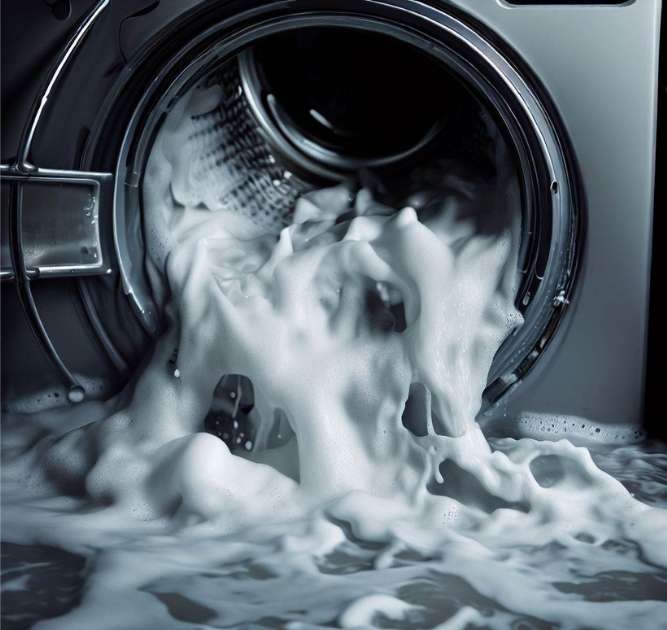Backflow is the undesirable reversal of water flow in a plumbing system, which can lead to contaminated water mixing with the clean water supply.
This poses a serious health hazard and can result in property damage.
Keeping backflow in check is crucial for maintaining water quality and water safety in your home.
So, does a washing machine need a backflow preventer in the first place?
Most modern washing machines have built-in backflow prevention and connect to sewage via standpipes. Additional backflow preventers are generally not needed but may be required in specific circumstances to prevent flooding and water contamination.
In this article, we’ll go through the roles of backflow preventers, what it is, and whether or not you should use one for your washing machine or not.
Table of Contents
What is a Backflow Preventer Used For?
A backflow preventer is a device installed in a plumbing system to prevent contaminated water from flowing back into the potable water supply.
It serves as a safeguard against cross-connection, where clean and contaminated water lines intersect.
The primary purpose is to maintain water quality and ensure water safety by eliminating the risk of sewer backup, sanitary sewer issues, and other forms of water contamination.
What Causes Washing Machine Backflow?
Washing machine backflow occurs when water flows back into the washing machine from the drain hose, usually due to a plumbing issue or sewer backup. This can happen for several reasons:
- Plumbing System Overload: When multiple appliances are used simultaneously, it can overload the plumbing system, causing backflow.
- Drain Hose Position: If the drain hose is not properly installed or is positioned too low, it can lead to backflow.
- Flooding: In areas prone to flooding, water can flow back into the washing machine, causing contamination.
- Cross-Connection: A faulty or missing backflow preventer can also lead to backflow if there is a cross-connection in the plumbing system.
Do Washing Machines Have Backflow Preventers?
Most washing machines come with built-in backflow preventers to enhance backflow protection. These internal mechanisms ensure that wastewater from the washing machine flows only in one direction into the drain, thereby, preventing any reverse flow that could lead to water contamination or property damage.
However, the effectiveness of the backflow preventer is closely tied to the maintenance of the washing machine’s drain hose and associated plumbing system.
Regular cleaning of the drain hose and checking for clogs in the p-trap can help maintain the preventer’s effectiveness and prevent backflow issues.
Does A Washing Machine Need a Backflow Preventer?
In most cases, washing machines do not require a separate backflow preventer because they usually have built-in mechanisms designed to prevent backflow. These mechanisms help ensure that dirty water does not contaminate your home’s water supply.
However, proper installation is crucial, also, the drain hose should be elevated and secured to prevent backflow.
With all that said, if the washing machine’s drain is at a greater height i.e., 8 feet or above, you may need to consider a backflow preventer as not all washers will be capable of pumping the wastewater into a drain that’s too high.
If you have concerns about backflow or experience issues with your washing machine’s drainage system, you may consider installing additional backflow prevention measures, such as check valves or air gaps, in the drain line.
These extra precautions can further reduce the risk of backflow and ensure the safe operation of your washing machine.
Also Read: Maximum Drain Height for Washing Machines (Explained)
Factors to Consider When Determining Whether a Washing Machine Needs a Backflow Preventer

While most washing machines come with built-in backflow preventers, there are certain factors that may necessitate additional backflow prevention measures.
Here are some key considerations before installing a backflow preventer:
The Location of the Washing Machine
The location of your washing machine can significantly impact the risk of backflow.
If your machine is located in a basement or an area prone to flooding, additional backflow prevention may be required to safeguard against water contamination.
The Type of Plumbing System
Different plumbing systems have varying susceptibilities to backflow issues.
Older plumbing systems without modern backflow preventers may be more prone to water contamination and sewer backup, necessitating additional preventive measures.
The Risk of Flooding
Areas that are prone to flooding pose a higher risk of backflow.
In such cases, additional backflow prevention measures, such as installing a check valve or an air gap is recommended in order to protect against water contamination and property damage.
How Does a Washing Machine Backflow Preventer Work?
A washing machine backflow preventer functions by allowing water to flow in only one direction from the washing machine to the drain. It employs a series of valves or mechanisms that close automatically if there is any reverse flow, thereby preventing water contamination and sewer backup.
The effectiveness of this device is closely tied to the plumbing system and the drain hose, which must be properly installed and maintained to ensure optimal backflow prevention.
Types of Backflow Preventers for Washing Machines
Check Valve
A check valve, also known as a non-return valve or one-way valve, allows fluid to flow in one direction only.
It is a simple valve that opens when there is forward pressure and closes when there is backflow or reverse pressure.
Check valves are typically used in applications where preventing backflow is essential, such as in pipelines and pumps.
Double Check Valve
A double-check valve is a more complex backflow prevention device designed to provide additional protection against backflow in potentially hazardous situations.
It consists of two check valves arranged in series with a chamber between them.
Double-check valves are commonly used in water supply systems to prevent contamination of potable water and offer an extra layer of protection compared to a single check valve.
Reduced Pressure Zone (RPZ) Valve
RPZ (Also known as Reduced Pressure Zone) valves provide a higher level of protection against backflow.
They consist of two check valves, similar to the double check valve, but also include a relief valve that opens to discharge water if backflow occurs.
Pressure Vacuum Breaker (PVB)
Pressure Vacuum Breakers (PVBs) are commonly used in outdoor irrigation systems.
They prevent backflow by creating an air gap between the water supply and the potential contamination source.
Atmospheric Vacuum Breaker (AVB)
Atmospheric Vacuum Breakers (AVBs) are used in applications with low or moderate hazard levels.
They create an air gap similar to PVBs but are typically smaller and less complex.
Benefits of Installing Backflow Preventers
Installing a backflow preventer in your washing machine or plumbing system comes with several benefits that go beyond just preventing water contamination.
Here are some key advantages of installing backflow preventers:
Water Safety
One of the primary benefits of a backflow preventer is enhanced water safety.
By preventing contaminated water from entering your potable water supply, you protect your family from potential health hazards.
Clean Pure Water
A backflow preventer ensures that your water supply remains free from contaminants, providing you with clean, pure water for drinking, cooking, and bathing.
Legal Compliance
In many jurisdictions, installing a backflow preventer is not just a safety measure but also a legal requirement.
Compliance with local plumbing codes can save you from fines and legal issues.
Avoid Expensive Repairs
Backflow can cause significant property damage, including damage to your plumbing system and washing machine.
Installing a backflow preventer can help you avoid expensive repairs down the line.
Disadvantages of Backflow Preventer
While backflow preventers offer numerous benefits, they also come with some drawbacks that homeowners and businesses should consider:
Maintenance Requirements
Backflow preventers require regular maintenance and testing to ensure they function correctly.
Failure to maintain them can lead to malfunction and compromise water quality.
Initial Cost
The initial cost of installing a backflow preventer can be high.
This includes the cost of the device itself, professional installation, and ongoing testing, making it a potential financial burden for homeowners and businesses.
Limited Lifespan
Backflow preventers have a finite lifespan and may need to be replaced periodically. This ongoing replacement cost can be a disadvantage for property owners.
Risk of Malfunction
If not properly maintained, backflow preventers can malfunction, allowing contaminated water to enter the clean water supply.
This poses a health hazard and can result in water contamination.
Limitations in Preventing All Backflow
While backflow preventers are effective in many situations, they may not prevent all types of backflow events.
Extreme water pressure changes, for example, can challenge their effectiveness.
Complex Installation
Installing a backflow preventer can be a complex process that typically requires professional expertise.
This complexity adds to the overall installation cost.
How Long Should a Backflow Device Last For?
The lifespan of a backflow preventer can vary depending on the type of device, the quality of the water, and how well it is maintained. However, most backflow preventers are designed to last between 3 to 5 years. It’s crucial to regularly inspect and maintain your backflow preventer to ensure it functions effectively throughout its lifespan.
Washing Machine Backflow Preventer Alternatives
Hose Bib Vacuum Breaker
This is a small device that can be attached to a hose bib (spigot).
It allows water to flow out but not back in, providing a simple form of backflow prevention. This is generally used for garden hoses but can be adapted for washing machine use.
Standpipe
A standpipe is a vertical pipe attached to a trap, into which a washing machine drains.
The height of the standpipe prevents water from flowing back into the machine. This is a common setup for washing machines and offers a form of backflow prevention.
Looping the Drain Hose
In some cases, simply looping the drain hose of the washing machine up and then down before connecting it to the drain can provide a rudimentary form of backflow prevention.
However, this is not a foolproof method and may not meet local plumbing codes.
Also Read: Are All Washing Machine Hoses the Same?
Manual Shutoff Valve
Though not a direct alternative to a backflow preventer, a manual shutoff valve allows you to control the water supply to the washing machine manually.
This can be useful in emergency situations to prevent backflow.
Final Thoughts
Whether or not a washing machine needs a backflow preventer depends on a variety of factors, including the plumbing system, location, and risk of flooding.
Consulting with a professional plumber can help you determine the best course of action for your home.
Remember, the risk of backflow is greatest in areas prone to flooding and can also occur if the washing machine’s drain hose is not properly installed.
Also, regular inspection and maintenance of your backflow preventer are vital to ensure it is working effectively and to extend its lifespan.
You May Also Like
- What’s the Average Height of a Washing Machine?
- How To Replace The Drain Hose In Washing Machine?
- Washing Machine Drain Pump: 9 Answers you must know
- How to Vent a Washing Machine Drain Pipe? (Step-by-Step)
- The Truth About Where Your Washing Machine Drain Water Goes
- Remove the drain hose from Maytag Washing Machine Safely
- Why does the sink gurgle when the washing machine drains?





